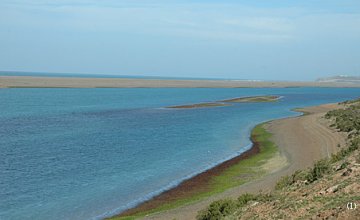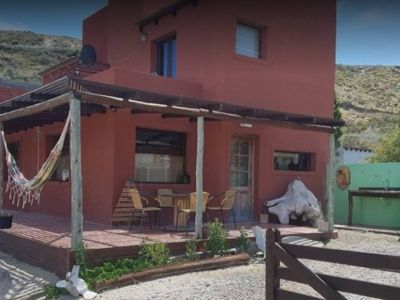Puerto Madryn is the major tourist resort in the Patagonian coast and it is, as well, the entrance gate to the Valdés Peninsula, where one of the most colossal and worldwide admired show is presented: southern right whale watching. The feeling of finding the horizon line through the vast Argentinian sea and watching these magnificent cetaceans led us to embark on this trip. We arrived at night. The entrance to the city was a revelation. From the high Patagonian steppe, we watched the panoramic sight of thousands of lights spreading all around. The vision gave us a complete idea about the size of the place we were visiting.
Where the Whales Rule
In this opportunity, we stayed at the Apart Ty Coed. We had a rest from our exhausting trip in these modern and warm facilities, recovering our energy in order to enjoy the intense day that waited for us the following morning. The feeling of staying under the sheets disappeared after a hot shower and the delicious breakfast prepared by the apart staff. Hot toast, homemade croissants, dulce de leche and sauco jam, plus the aromatic black coffee would please our morning appetite. Very punctually, the shuttle from Tito Botazzi picked us up. It was 7.30 in the morning.
Towards the Valdés Peninsula
We left the city through Provincial Route 1. The desolate landscape of pure Patagonian steppe to our left would be balanced with the deep blue of the ocean that watered the shore to the right of our vehicle. We took Provincial Route 2 heading for the Carlos Ameghino Isthmus, the only link between the peninsula and the continent. In its narrowest part, it is six kilometers wide. At this point, we could observe the two gulfs that flank it: the San José, to the North and the Nuevo, to the South, which was our destination. We paid for the entrance ticket to the Fauna Reserve and we continued to Puerto Pirámides, the only urban settlement in the entire peninsula from where expeditions leave to enjoy the so-longed boat whale watching. By then, we had traveled 97 kilometers up to our destination.Whales in Sight
Thousands of tourists reach this point of the country from all round the world, eager to approach the giant cetaceans and obtaining “the photograph” of their jump or of their huge raised flukes. The contagious enthusiasm was transmitted to all the attendants. We were supplied waterproof coats and life jackets. The day was warm, the temperature pleasant, but the wind blowing from the East would announce that we would not fulfill our expectations. Anyway, we advanced into the deep and salty sea waters. The right whales may be spotted from June to December, when they reach the Nuevo Gulf in order to mate or bear their calves. We set off on the comfortable craft and did not take too long to see the first whale that approached us curiously. A colossal dark mass emerge suddenly from the surface of the water to fall again into it, making an incredible noise, maybe saying to us: “Hello humans, here I am”. As we watched the show, the guide of the craft told us some of the most important characteristics of these large fellows.ouettes in the Sea
“The southern right whale has a curved body and no dorsal fin. Adult females measure between 13 and 16 meters of length, whereas the males only reach 12. The adults may weight between 30 and 40 tons” – the guide explained. “In their mouth, which is curved, some 260 plates or horn-like sheets originally called baleen, from where the Spanish name ballena derives” – he added. We continue sailing. Suddenly, another whale showed its giant flukes, measuring about five meters, over the surface of the water and stayed there with its head down for a long while, abandoned to the whims of the wind. Afterwards, we were so lucky as to watch a female with its new born calf. The gestation period is of 12 months and the female feeds her calf, which at the moment of birth reaches a length of 5.5 meters, for another 12. When these animals are ready to breed, the come back to the Valdés Peninsula area every three years, searching for safe and quiet waters to bear another calf. The guide continued with its master talk: “In the upper part of their head, they have some callosities which are their “identification mark”. They work just like fingerprints, as they are unique marks.” We knew that behind the callosities we could see the blowholes, used by the animal to breathe and blow the air from its lungs. An interesting piece of information that we wish to share is that in order to avoid alterations during the mating and breeding period, the Province of Chubut allows navigation only in the Nuevo Gulf and only to tourist agencies crafts, which must in turn have the corresponding authorization provided by the Prefectura Naval Argentina. Therefore, whale watching is totally regulated in order to protect the integrity of the right whales, declared Natural Monument in the year 1984. We were delighted by the wonderful performance. We can tell thousands of curious characteristics of these gigantic cetaceans, such as their way of breeding, birth and habits. But it is better that you discover it yourself and learn about them when you pay a visit. While we were watching them and learning about them, time –approximately an hour and a half– slipped like water through our fingers. Leaving from Puerto Madryn along Provincial Route 1 and then along Nº 2, the Carlos Ameghino Isthmus is reached after traveling 77 km. From there, the San José and the Nuevo Gulfs are made out. 20 kilometers must be traveled eastwards from the Isthmus to Puerto Pirámides. From Viedma, take National Route 3 towards the South, passing by the Las Grutas crossroad, up to the junction with Route 2, which must be taken heading eastwards up to Puerto Pirámides, and then taking the route described in the paragraph above. Marcelo Sola
Jorge González
Contact of the excursion or tour
1º Bajada al mar, Puerto Pirámides, Chubut, Argentina
Phone: +54 280-4474110
Cell Phone: +54 280-4363690
Southern Spirit- Yellow Submarine
1º Bajada al Mar, Puerto Pirámides, Chubut, Argentina
Phone: +54 280-4495094
Cell Phone: +54 280-4572551
2º Bajada al mar, Puerto Pirámides, Chubut, Argentina
Phone: +54 280-4495112
Cell Phone: +54 280-4992014
Peke Sosa Avistajes
2º Bajada al mar, Puerto Pirámides, Chubut, Argentina
Phone: +54 280-4495010
Whales Argentina
Primera bajada al mar s/n, Puerto Pirámides, Chubut, Argentina
Phone: +54 280-4495015
Cell Phone: +54 280-4663782
Hydrosport
1º Bajada al mar, Puerto Pirámides, Chubut, Argentina
Phone: +54 280-4722614
Cell Phone: +54 280-4634678
From Viedma, take National Route 3 towards the South, passing by the Las Grutas crossroad, up to the junction with Route 2, which must be taken heading eastwards up to Puerto Pirámides, and then taking the route described in the paragraph above.

































